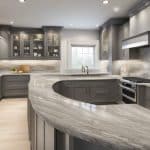Types Of Homes
Types of homes vary from traditional to modern designs, from single-family homes to condominiums, and from small apartments to large estates. Each type of home has its own unique characteristics, advantages, and disadvantages. Understanding the different types of homes can help you choose the one that best suits your lifestyle, preferences, and budget.
Historical and architectural home styles have influenced the design and construction of homes throughout history. From the colonial style of the 1600s to the modern and contemporary designs of today, each style has its own distinct features and characteristics. Some popular architectural styles include Cape Cod, Mediterranean, Tudor, and Victorian. By understanding the history and features of each style, you can choose a home that matches your personal taste and style.
Modern and contemporary home designs have become increasingly popular in recent years. These homes often feature open floor plans, large windows, and minimalist designs. They are designed to be energy-efficient and environmentally friendly. Some popular modern and contemporary home designs include mid-century modern, ranch-style, and split-level homes. By choosing a modern or contemporary home, you can enjoy the latest in home design and technology.
Key Takeaways
- Understanding the different types of homes can help you choose the one that best suits your lifestyle, preferences, and budget.
- Historical and architectural home styles have influenced the design and construction of homes throughout history.
- Modern and contemporary home designs have become increasingly popular in recent years.
Historical and Architectural Home Styles

When it comes to historical and architectural home styles, there are many different types to choose from. Each style has its own unique characteristics that make it stand out from the rest. In this section, we will explore some of the most popular historical and architectural home styles, including Victorian and Tudor, Colonial and Georgian, Cape Cod and Craftsman.
Victorian and Tudor
Victorian homes are known for their ornate details, steep roofs, and asymmetrical shapes. They were popular in the late 19th century and are often associated with the Queen Anne style. Tudor homes, on the other hand, are characterized by their steeply pitched roofs, decorative half-timbering, and tall, narrow windows. They were popular in the UK during the 15th and 16th centuries, and then again in the 19th and 20th centuries.
Colonial and Georgian
Colonial homes are one of the oldest home styles in America. They are characterized by their symmetrical shape, simple design, and often feature a central chimney. Georgian homes are similar to Colonial homes, but are more ornate and feature decorative details such as pediments, columns, and cornices. They were popular in the 18th century and are often associated with the Federal style.
Cape Cod and Craftsman
Cape Cod homes are known for their simple, symmetrical design and steep roofs. They were popular in the 1920s and 1930s and are often associated with the Colonial Revival style. Craftsman homes, on the other hand, are characterized by their low-pitched roofs, exposed rafters, and use of natural materials. They were popular in the early 20th century and are often associated with the Arts and Crafts movement.
Overall, historical and architectural home styles offer a wide range of options for homeowners. Whether you prefer the ornate details of a Victorian home or the simple design of a Cape Cod, there is a style that will suit your taste and needs.
Modern and Contemporary Home Designs
Modern and contemporary home designs are marked by their sleek and minimalist aesthetic. These designs are characterized by clean lines, open floor plans, and the use of materials such as glass, concrete, and steel. They often feature horizontal lines and a focus on functionality over ornamentation.
Mid-Century Modern
Mid-century modern homes were popularized in the 1950s and 1960s, and are still popular today. These homes are known for their use of natural materials, such as wood and stone, and their integration with the surrounding landscape. They often feature large windows and open floor plans, which create a seamless transition between indoor and outdoor spaces.
Contemporary and Prairie
Contemporary and prairie-style homes are more recent additions to the modern and contemporary design landscape. These homes often feature flat or low-pitched roofs, and are characterized by their use of clean lines and simple geometric shapes. Prairie-style homes often feature horizontal lines and a focus on the natural environment, while contemporary homes may incorporate more high-tech materials and design elements.
Minimalist and High-Tech
Minimalist and high-tech home designs are becoming increasingly popular. These homes often feature a combination of clean lines, open floor plans, and high-tech materials and systems. They may incorporate features such as smart home technology, energy-efficient appliances, and sustainable building materials.
Overall, modern and contemporary home designs are marked by their clean lines, open floor plans, and focus on functionality. Whether you prefer the natural materials and integration with the surrounding landscape of mid-century modern homes, the geometric shapes and emphasis on the natural environment of prairie-style homes, or the high-tech features of minimalist and high-tech homes, there is a modern or contemporary home design that is right for you.
Home Types by Structure and Ownership
When it comes to homes, there are various types that exist, ranging from single-family homes to condos, co-ops, and mobile homes. These types can be classified based on their structure and ownership.
Single-Family and Multi-Family Homes
Single-family homes are typically detached, standalone structures that are designed to house one family. They are usually located on a plot of land that is owned by the homeowner and can range from small bungalows to large mansions.
On the other hand, multi-family homes are structures that are designed to house more than one family. These can be duplexes, triplexes, or apartment buildings. Multi-family homes can be owned by a single owner or by multiple owners who each own a unit in the building.
Condos and Co-ops
Condos and co-ops are similar in that they are both types of housing that involve shared ownership. However, they differ in the way ownership is structured.
In a condo, the homeowner owns the unit they live in and shares ownership of the common areas with other condo owners. In contrast, co-op owners do not own their individual units but instead own shares in the entire building. This means that co-op owners have more restrictions on what they can do with their unit, such as subletting or making major renovations.
Mobile and Manufactured Homes
Mobile and manufactured homes are types of housing that are designed to be moved. Mobile homes are built on a chassis with wheels, while manufactured homes are built in a factory and transported to a site.
These types of homes are usually less expensive than traditional homes and can be a good option for those who want to own their own home but have a limited budget. However, they can also be more difficult to finance and may not appreciate in value as much as traditional homes.
Overall, there are many different types of homes available, each with their own benefits and drawbacks. By understanding the different types of homes and their structures and ownership, potential homeowners can make an informed decision about which type of home is right for them.
Specialized and Alternative Housing
There are many types of homes available to accommodate different lifestyles and preferences. Some individuals prefer to live in specialized and alternative housing options that are unique and unconventional. These types of homes can range from tiny homes and container homes to mansions and castles.
Tiny Homes and Container Homes
Tiny homes and container homes have become increasingly popular in recent years due to their affordability, sustainability, and flexibility. These types of homes are typically smaller in size and can be built on a trailer or foundation. They are often designed to maximize space and minimize waste, making them ideal for individuals who value simplicity and minimalism.
Container homes are made from shipping containers and can be customized to fit the owner’s unique needs and preferences. They are durable, low-maintenance, and can be easily transported. Tiny homes, on the other hand, can be built using a variety of materials and can be designed to suit different styles and tastes.
Houseboats and Yurts
Houseboats and yurts are other alternative housing options that are gaining popularity among individuals who enjoy living close to nature. Houseboats are floating homes that can be used as primary residences or vacation homes. They offer stunning water views and the freedom to travel to different locations.
Yurts, on the other hand, are circular tents that are typically used by nomadic people. They are made from a wooden frame and covered with canvas or other materials. Yurts can be used as permanent homes or as temporary accommodations for camping or glamping. They are eco-friendly, portable, and provide a unique living experience.
Mansions and Castles
For those who prefer a more luxurious lifestyle, mansions and castles are popular choices. These types of homes are typically large, grand, and opulent. They offer ample space for entertaining, hosting guests, and showcasing artwork and other collections.
Mansions are often located in upscale neighborhoods and feature modern amenities such as swimming pools, home theaters, and wine cellars. Castles, on the other hand, are typically historic buildings that have been renovated and restored. They offer a glimpse into the past and provide a unique living experience for those who appreciate history and architecture.
In conclusion, specialized and alternative housing options are becoming more popular as individuals seek to live in homes that reflect their unique personalities and lifestyles. From tiny homes and container homes to houseboats and yurts, there are many different types of homes available to suit different needs and preferences. Mansions and castles offer a more luxurious living experience for those who prefer grandeur and opulence.
Home Design Elements and Considerations
When it comes to designing a home, there are several elements to consider. From the floor plans and layouts to the materials and construction, every aspect of the design can impact the overall look and feel of the home. Here are some key considerations to keep in mind:
Floor Plans and Layouts
The floor plan and layout of a home can greatly impact its functionality and flow. Some popular floor plans include open-concept layouts, which allow for a seamless transition between rooms, and split-level designs, which offer more privacy and separation between living spaces. Bay windows are a popular design element that can add both style and functionality to a home, providing additional natural light and a cozy reading nook.
Materials and Construction
The materials and construction of a home can also impact its overall aesthetic and durability. Wood is a classic building material that can add warmth and character to a home, while concrete is a durable and low-maintenance option that can offer a modern look. Stucco walls are another popular design element that can add texture and visual interest to a home.
Privacy and Utilities
Privacy and utilities are also important considerations when designing a home. Homeowners may want to consider the placement of windows and doors to maximize privacy, as well as the location of utilities such as HVAC systems and water heaters to ensure easy access and maintenance. The Arts and Crafts movement, which emphasizes craftsmanship and natural materials, is a popular design style that can offer both privacy and functionality in a home.
Overall, designing a home requires careful consideration of several key elements. By taking into account the floor plan, materials, and utility placement, homeowners can create a space that is both functional and visually appealing.






